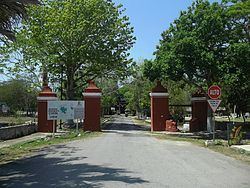Postal code 97316 | Mexican States Yucatán Time zone CST (UTC−6) Area code 999 | |
 | ||
The Cuxtal Ecological Reserve is located south of Mérida in the state of Yucatán in southeastern Mexico. It is a designated "green space" for the Mérida Municipality made up of 21,514 acres (10,757 hectares) of land that was designated in 1993 as an ecological and historic preservation area. It contains 7 historic haciendas, archaeological sites, cenotes as well as a nature preserve and the Biological Sciences campus for UADY.
Contents
ToponymyEdit
The name (Cuxtal) is a word from the Mayan language meaning birth or life.
How to get thereEdit
Take Calle 50 just south of the Periférico to Calle 161. The reserve is between Calle 161 and 163 on the north and south, bounded by Calle 50 on the east and Calle 50C on the west. The preservation area extends in a loop for approximately 65 km. From the entrance of the reserve to the farthest hacienda, Dzoyaxché, it is 32 km.
HistoryEdit
On 28 June 1993 the area was designated to protect the history of the 7 large haciendas, their adjoining pueblas, 12 minor archaeological sites, 6 cenotes and one of Mérida's important water supply stations. There are also two police commissaries in the reserve, as well as the Biology and Agricultural Sciences Campus of the Autonomous University of Yucatan (UADY). The Faculty of Veterinary Medicine and Animal Husbandry is also located on the campus which is near Xmatkuil.
Besides preservation of the man-made history of the area, the reserve serves as an important part of Mérida's green beltway. The vegetation of Cuxtal is lush and primarily a deciduous forest. The reserve is also home to a variety of wildlife, typical to the area, such as armadillos, white-tailed deer, reptiles and various species of birds. The wildlife also serve important functions for scientific investigation. Over a 36-month period, birds were trapped, tagged, blood samples were drawn and the birds then released. 182 species were identified within the time from 2001-2003. Five of the birds showed evidence of infection with West Nile Virus.
Near the village of San Ignacio Tesip, an interactive park called "Bee Planet" was opened in 2013 with the dual purpose of studying the melipona bee and allowing students and the public to see the production techniques, observe research, and taste the honey produced. Yucatán is the largest producer of honey in Mexico and the project was designed to revive agriculture and husbandry in the area which declined after the bust of the Henequen industry in Yucatán.
In 2014 efforts were redoubled to keep the area protected after it was revealed that the northernmost areas near the Periférico had been deforested by urban expansion. Plans were being reviewed on whether to try to reforest the damaged areas or require that owners plant trees on their properties.
CommunitiesEdit
There are 7 police substations and 2 stations in the reserve which is made up of the 9 communities:
Within the communities are the following protected haciendas:
